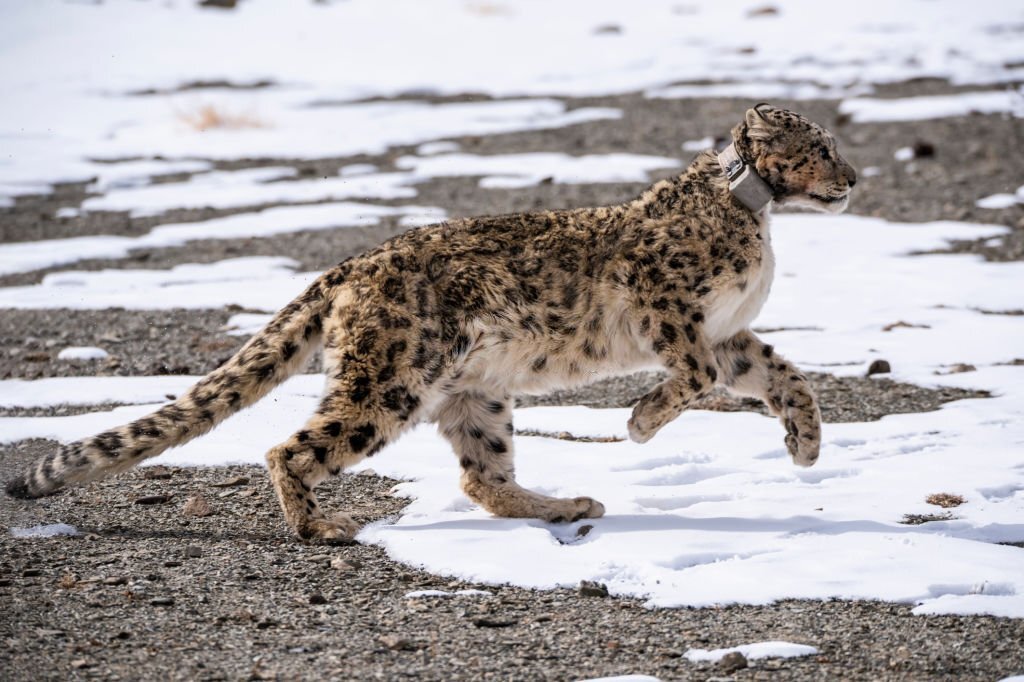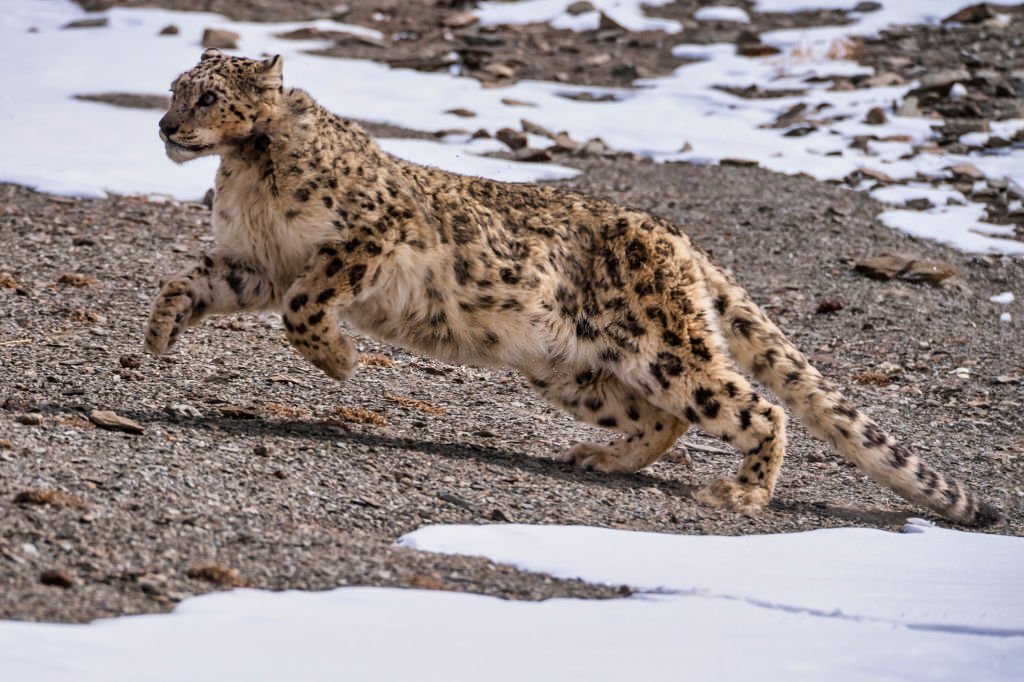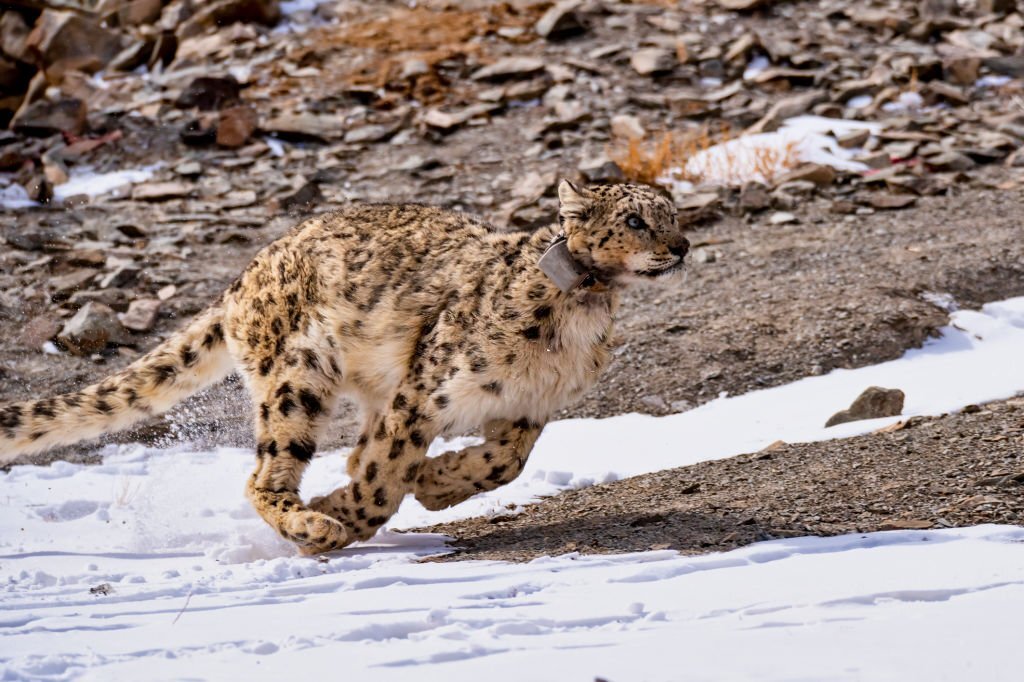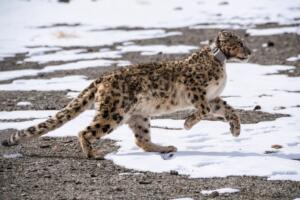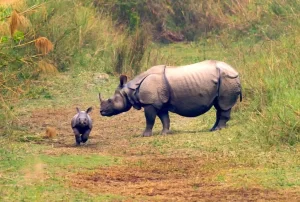The snow leopard (Panthera uncia) is believed to have originated in the mountainous regions of Central and South Asia, including parts of India. The high-altitude parts of the Himalayas are home to these elusive big cats. They are on the list of endangered species. Even though no one knows for sure where snow leopards came from, it is thought that they have lived in the area for thousands of years. The Indian states of Leh & Ladakh, Himachal Pradesh, Uttarakhand, and Sikkim all have snow leopards.
Characteristics of Snow Leopard
Here are some characteristics of snow leopards:
- Appearance: Snow leopards have white or gray coats with black spots that help them blend in with their snowy surroundings. Their long tail helps them stay balanced and move quickly on rocky ground.
- Size: An adult snow leopard usually weighs between 60 and 120 pounds and can reach a shoulder height of 2 to 2.5 feet. Their bodies can be between 3.5 and 4.5 feet long, and their tails can be between 3 and 3.5 feet long.
- Habitat: Snow leopards are found in the high-altitude regions of Central and South Asia, including the Himalayas, at elevations of 9,800 to 17,000 feet.
- Diet: Snow leopards are carnivorous and primarily eat wild sheep and goats, as well as smaller mammals such as marmots and pikas.
- Behavior: Snow leopards live alone and are hard to find. They spend most of their time in rocky cracks and outcroppings. They are very flexible and can survive in all kinds of weather.
- Threats: Snow leopards are an endangered species and face threats such as habitat loss, poaching, and climate change. It is estimated that there are only around 4,000-6,500 snow leopards left in the wild.
Snow Leopard Tours in India
- Snow Leopard Expedition to Kibber Valley
- Snow Leopard Tour of Leh, India
- Big Cats of India Tour – Witness Snow Leopard, Bengal Tiger, Indian Leopard & Asiatic Lion
- Snow Leopard & Big Cats of India Tour
Explore other wildlife & tiger safari tours in India
Differences between Snow Leopard & Common Indian Leopard
Here are some key differences between snow leopards and common leopards:
- Habitat: Snow leopards live in the highlands of Central and South Asia, such as the Himalayas. Common leopards, on the other hand, live in a wider variety of places, from grasslands to forests to deserts.
- Appearance: Snow leopards have a distinctive white or gray coat with black spots, while common leopards have a yellow or gold coat with black spots. Snow leopards have longer, thicker tails than common leopards.
- Size: Snow leopards are slightly smaller than common leopards, with males weighing between 77-120 pounds and females weighing between 55-99 pounds, compared to common leopards, which can weigh between 66-200 pounds.
- Diet: Snow leopards primarily eat wild sheep and goats, while common leopards have a more varied diet and may also eat smaller mammals, birds, and reptiles.
- Behavior: Snow leopards and common Leopards both are solitary and elusive animals. Snow leopards also have a slower metabolism and are less active than common leopards.
- Conservation status: The snow leopard is on the list of endangered species, and the common leopard is on the list of vulnerable species. Snow leopards are in danger from things like habitat loss, poaching, and climate change. Common leopards are also in danger from habitat loss, poaching, and human conflicts.
| Characteristic | Snow Leopard | Common Leopard |
| Habitat | High-altitude regions of Asia | Various habitats in Africa/Asia |
| Appearance | White/gray coat with black spots | Yellow/gold coat with black spots |
| Size | Males: 77-120 lbs, Females: 55-99 lbs | Males: 66-200 lbs, Females: 44-132 lbs |
| Diet | Primarily wild sheep and goats | A varied diet including mammals, birds, reptiles |
| Behavior | Solitary and elusive | Solitary and elusive |
| Conservation Status | Endangered | Vulnerable |
Best practices to spot Snow Leopard in India
Spotting a snow leopard in the wild can be a challenging and rare experience, but here are some tips on how to increase your chances of seeing one in India:
- Visit national parks and conservation areas: Snow leopards live in protected areas in India, such as Hemis National Park, Nanda Devi National Park, and Kibber Wildlife Sanctuary. If you go to these places in the winter, when snow leopards come down to lower altitudes to look for food, you are more likely to see one.
- Hire a local guide: Local guides who are familiar with the terrain and snow leopard behavior can greatly increase your chances of spotting a snow leopard. They can also help you identify tracks and other signs of snow leopard activity.
- Look for tracks and other signs: Snow leopards leave tracks and other signs of their presence, like scratches on trees and poop, when they go somewhere. Look for these signs to find out where snow leopards might be hunting or traveling.
- Use binoculars and spotting scopes: Snow leopards are often spotted from a distance, so using binoculars and spotting scopes can help you get a better view. Look for movement and any unusual shapes or colors that stand out against the snow.
- Be patient and quiet: Spotting a snow leopard can take time, so be patient and allow yourself enough time to scan the landscape. Also, be quiet and respectful of the environment, as loud noises and disturbances can scare away the animals.
Threats faced by Snow Leopards in India
Snow leopards in India face several threats, including:
- Habitat loss: Snow leopards live in remote, high-altitude areas that are also used by people to graze livestock, gather firewood, and do other things. Because of this, their habitat is being destroyed or ruined, which makes it harder for them to find food and makes it more likely that they will fight with people.
- Poaching and illegal wildlife trade: Snow leopards are poached for their bones, fur, and other body parts, which are highly valued in traditional Asian medicine and the illegal wildlife trade.
- Retaliatory killing: Snow leopards occasionally prey on livestock, and in retaliation, they are often killed by herders who view them as a threat to their livelihoods.
- Climate change: Climate change is affecting the snow leopard’s habitat by altering weather patterns, reducing snow cover, and changing vegetation patterns, which may affect prey availability and disrupt the snow leopard’s movements.
- Lack of awareness and conservation efforts: In India, people still don’t know or understand how important it is to protect snow leopards, and there aren’t enough conservation measures in place to protect them and their habitat.
Efforts are underway to address these threats through snow leopard conservation and community-based initiatives, such as creating protected areas, providing incentives for communities to coexist with snow leopards, and increasing awareness about the importance of conservation.
Snow Leopard conservation projects in India
India has several snow leopard conservation projects to protect the species and its habitat. Some of the major initiatives are:
- Project Snow Leopard: This project, which started in 2009, is a partnership between the Indian government, local communities, and conservation groups. Its goal is to protect the snow leopard and its habitat. Its main goal is to protect the species and encourage sustainable growth in the high-altitude areas where it lives.
- Snow Leopard Conservation and Development Program (SLCDP): This program aims to promote sustainable development in snow leopard habitats by providing economic incentives for communities to coexist with the species. It also focuses on raising awareness about the importance of conserving snow leopards and their habitat.
- Himalayan High-Altitude Wetlands Conservation and Management Program (HIMCON): Launched in 2016, this program is aimed at conserving high-altitude wetlands in the Himalayas, which are important habitats for snow leopards and other species.
- Community-Managed Ecotourism: This program helps local communities set up and run eco-tourism activities in snow leopard habitats, which can bring in money and help protect the animals.
- Species Recovery Program: This program focuses on protecting and recovering endangered species, including snow leopards, by developing recovery plans, creating protected areas, and increasing conservation efforts.
Overall, these projects are helping to increase awareness about the importance of conserving snow leopards in India and are providing much-needed support for conservation efforts. However, continued efforts and funding are needed to ensure the species long-term survival.

